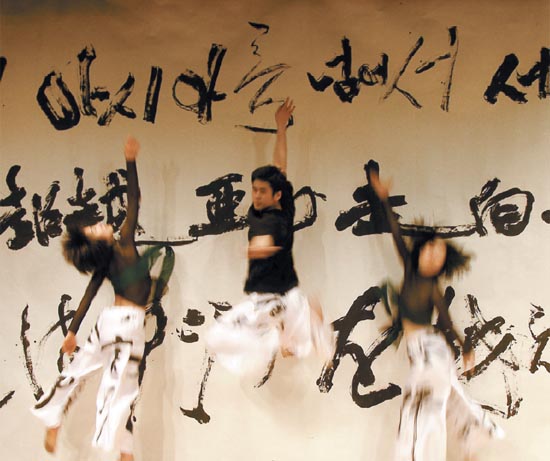Calligraphy springs from page to stage in Jeonju fest

Dancers perform in “Pilgamukmu” in front of a backdrop created by 15 calligraphers in this photo from the 2009 World Calligraphy Biennale of Jeollabuk-do. The work will be presented again at this year’s festival, which starts Saturday and continues until Oct. 30 in Jeonju, North Jeolla. [JoongAng Ilbo]
Calligraphy has been described in many ways - as a beautiful, expressive and meditative art - and “active” is not often part of the description.
But one festival dedicated to the art form is trying to change the perception of calligraphy as slow.
The World Calligraphy Biennale of Jeollabuk-do, now in its eighth year, has chosen “Dynamic” as its theme to demonstrate one of its lesser known, yet no less important, attributes.
“The reason we chose ‘dynamic’ as the theme is not only to emphasize the degree of inner activity required for skillful writing, but also to show our ambition to boost awareness of calligraphy around the world,” Heo Jin-gyu, the executive director of the event, wrote in a statement on the Web site.
The festival starts this Saturday and continues until the end of October at various museums in Jeonju, North Jeolla.
Festival organizers speculate that the view of calligraphy as a slow art has hindered its development.
To demonstrate calligraphy’s dynamism, the festival will get started with a performance of “Pilgamukmu,” which was first presented at the 2009 calligraphy biennale. The work - whose title is a portmanteau of the Korean words for brushes, music, ink and dance - features five dancers who perform against a backdrop created by 15 calligraphers.
To get festivalgoers involved in the act of doing calligraphy, the festival offers a series of hands-on activities.
In one such activity, visitors learn how to make crafts such as boxes, shelves and ornaments that use hanji, or traditional Korean paper, as a wrapping material.
In another program, visitors take rubbings of reproductions of calligraphy works from temples or other historical buildings. Organizers hope the activity will show how the character of a piece of calligraphy changes depending on the material on which it was written.
To create a more festive atmosphere, visitors are invited to help decorate the festival venue by writing wishes with traditional Korean brushes on strips of colored paper. The strips of paper will then be hung outdoors around the festival site.
In addition to these activities, the festival also offers an exhibition called “Hangul 11,172” that demonstrates all the possible combinations that can be created from Hangul, the Korean alphabet. As the exhibition title indicates, the total number of combinations is 11,172.
The exhibition was created with the talents of 784 artists, each of which contributed 14 to 15 letters to a piece of paper that is 45 meters (148 feet) long. The exhibition is being held not only to demonstrate the beauty of Hangul but also shows the possibilities for Korean typography.
Another feature of the exhibition is a display of writings by prominent figures in Korean society, including Hong Seok-hyun, chairman of the JoongAng Ilbo; Cho Soon, former deputy minister for the economy; Yoo Hong-jun, former minister of culture; and 30 others.
*The 8th World Calligraphy Biennale of Jeollabuk-do starts this Saturday and runs through Oct. 30 in Jeonju, North Jeolla. Admission is free. To get to Jeonju, go to Nambu Express Bus Terminal and take a bus to Jeonju Express Bus Terminal. For more information, call (063) 241-4507~8, or visit www.biennale.or.kr.
By Lee Sun-min [summerlee@joongang.co.kr]










with the Korea JoongAng Daily
To write comments, please log in to one of the accounts.
Standards Board Policy (0/250자)